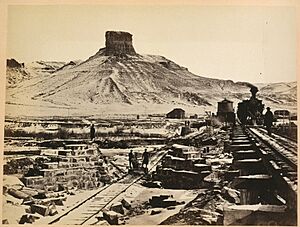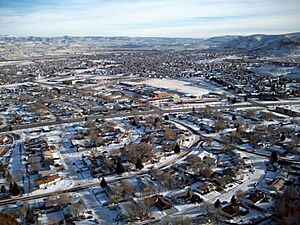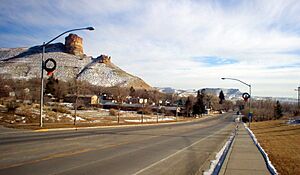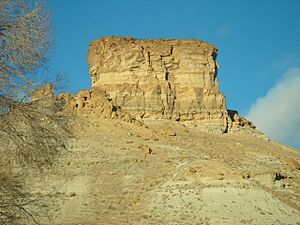Green River, Wyoming facts for kids
Quick facts for kids
Green River, Wyoming
|
|
|---|---|
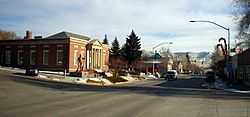
Downtown Green River, looking east at Flaming Gorge Way.
|
|
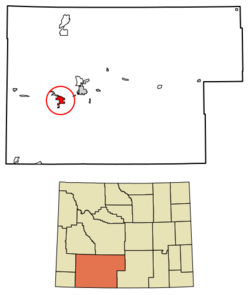
Location of Green River in Sweetwater County, Wyoming.
|
|
| Country | United States |
| State | Wyoming |
| County | Sweetwater |
| Area | |
| • Total | 14.11 sq mi (36.54 km2) |
| • Land | 13.81 sq mi (35.76 km2) |
| • Water | 0.30 sq mi (0.78 km2) |
| Elevation | 6,115 ft (1,864 m) |
| Population
(2020)
|
|
| • Total | 11,825 |
| • Density | 851.61/sq mi (328.81/km2) |
| Time zone | UTC−7 (Mountain (MST)) |
| • Summer (DST) | UTC−6 (MDT) |
| ZIP codes |
82935, 82938
|
| Area code(s) | 307 |
| FIPS code | 56-33740 |
| GNIS feature ID | 1589126 |
| Website | City of Green River |
Green River is a city in Sweetwater County, Wyoming, United States. It is the county seat, meaning it is the main government center for the county. In 2020, about 11,825 people lived there, making it the 7th largest city in Wyoming.
Contents
History of Green River
The city of Green River was planned by the Union Pacific Railroad in 1867. At first, it was part of the Dakota Territory. The town officially became a city on August 21, 1868. Later, in 1891, it was re-established under the laws of the new State of Wyoming.
The Union Pacific Railroad arrived in Green River on October 1, 1868. The railroad planned to make Green River an important stop. However, they found a town of 2,000 people already there. This would have made buying land very expensive. So, they moved their main stop about 12 miles (19 km) west to a new town called Bryan.
Green River almost became a ghost town (an empty town). But then, Bryan's water source dried up during a drought. The railroad needed water for its steam locomotives. So, they had to move their main stop back to Green River. This made Bryan the ghost town instead!
On May 24, 1869, a famous explorer named John Wesley Powell started his big river trip from Green River. This trip explored the Colorado River and the Grand Canyon.
In 1931, Green River passed a special rule called the Green River Ordinance. This rule made it illegal for people to sell things door-to-door without an invitation. Many other towns across the country later used this same rule.
Geography and Climate
Green River covers an area of about 14 square miles (36 square kilometers). Most of this area is land, with a small part being water.
Climate in Green River
Green River has a cold semi-arid climate. This means it is usually dry and can have very cold winters. The hottest temperature ever recorded was 104°F (40°C) on July 8, 1954. The coldest temperature was -42°F (-41°C) on December 31, 1978.
| Climate data for Green River, Wyoming, 1991–2020 normals, extremes 1897–present | |||||||||||||
|---|---|---|---|---|---|---|---|---|---|---|---|---|---|
| Month | Jan | Feb | Mar | Apr | May | Jun | Jul | Aug | Sep | Oct | Nov | Dec | Year |
| Record high °F (°C) | 59 (15) |
68 (20) |
77 (25) |
86 (30) |
94 (34) |
103 (39) |
104 (40) |
100 (38) |
98 (37) |
89 (32) |
73 (23) |
66 (19) |
104 (40) |
| Mean maximum °F (°C) | 47.9 (8.8) |
53.3 (11.8) |
64.6 (18.1) |
75.1 (23.9) |
83.7 (28.7) |
92.2 (33.4) |
96.2 (35.7) |
94.5 (34.7) |
89.6 (32.0) |
78.6 (25.9) |
63.6 (17.6) |
49.4 (9.7) |
96.8 (36.0) |
| Mean daily maximum °F (°C) | 31.0 (−0.6) |
36.1 (2.3) |
47.1 (8.4) |
56.4 (13.6) |
66.2 (19.0) |
78.1 (25.6) |
86.6 (30.3) |
85.0 (29.4) |
75.7 (24.3) |
60.7 (15.9) |
43.9 (6.6) |
32.0 (0.0) |
58.2 (14.6) |
| Daily mean °F (°C) | 19.6 (−6.9) |
24.5 (−4.2) |
34.8 (1.6) |
42.8 (6.0) |
51.9 (11.1) |
61.8 (16.6) |
69.7 (20.9) |
67.9 (19.9) |
58.3 (14.6) |
45.5 (7.5) |
31.4 (−0.3) |
20.9 (−6.2) |
44.1 (6.7) |
| Mean daily minimum °F (°C) | 8.1 (−13.3) |
12.9 (−10.6) |
22.5 (−5.3) |
29.3 (−1.5) |
37.6 (3.1) |
45.5 (7.5) |
52.9 (11.6) |
50.7 (10.4) |
40.9 (4.9) |
30.3 (−0.9) |
19.0 (−7.2) |
9.8 (−12.3) |
30.0 (−1.1) |
| Mean minimum °F (°C) | −13.4 (−25.2) |
−9.0 (−22.8) |
6.0 (−14.4) |
17.9 (−7.8) |
25.4 (−3.7) |
34.2 (1.2) |
43.9 (6.6) |
40.4 (4.7) |
29.9 (−1.2) |
14.8 (−9.6) |
1.1 (−17.2) |
−7.9 (−22.2) |
−17.9 (−27.7) |
| Record low °F (°C) | −40 (−40) |
−41 (−41) |
−26 (−32) |
−2 (−19) |
13 (−11) |
22 (−6) |
31 (−1) |
23 (−5) |
4 (−16) |
−9 (−23) |
−19 (−28) |
−42 (−41) |
−42 (−41) |
| Average precipitation inches (mm) | 0.69 (18) |
0.51 (13) |
0.84 (21) |
1.32 (34) |
1.67 (42) |
0.92 (23) |
0.49 (12) |
0.64 (16) |
0.87 (22) |
1.04 (26) |
0.69 (18) |
0.63 (16) |
10.31 (261) |
| Average snowfall inches (cm) | 6.3 (16) |
7.6 (19) |
5.4 (14) |
3.9 (9.9) |
0.9 (2.3) |
0.0 (0.0) |
0.0 (0.0) |
0.0 (0.0) |
0.3 (0.76) |
2.4 (6.1) |
5.0 (13) |
6.7 (17) |
38.5 (98.06) |
| Average precipitation days (≥ 0.01 in) | 5.2 | 4.8 | 6.2 | 7.4 | 9.1 | 4.9 | 4.6 | 5.4 | 6.1 | 6.0 | 5.1 | 5.8 | 70.6 |
| Average snowy days (≥ 0.1 in) | 4.9 | 4.7 | 3.4 | 2.3 | 0.4 | 0.0 | 0.0 | 0.0 | 0.1 | 1.4 | 3.7 | 5.1 | 26.0 |
| Source 1: NOAA | |||||||||||||
| Source 2: National Weather Service | |||||||||||||
People of Green River
| Historical population | |||
|---|---|---|---|
| Census | Pop. | %± | |
| 1870 | 106 | — | |
| 1880 | 327 | 208.5% | |
| 1890 | 723 | 121.1% | |
| 1900 | 1,361 | 88.2% | |
| 1910 | 1,313 | −3.5% | |
| 1920 | 2,140 | 63.0% | |
| 1930 | 2,589 | 21.0% | |
| 1940 | 2,640 | 2.0% | |
| 1950 | 3,187 | 20.7% | |
| 1960 | 3,497 | 9.7% | |
| 1970 | 4,196 | 20.0% | |
| 1980 | 12,807 | 205.2% | |
| 1990 | 12,711 | −0.7% | |
| 2000 | 11,808 | −7.1% | |
| 2010 | 12,515 | 6.0% | |
| 2020 | 11,825 | −5.5% | |
In 2010, there were 12,515 people living in Green River. There were 4,642 households and 3,406 families. Most people (92.1%) were White. About 13.4% of the population was Hispanic or Latino.
About 39% of households had children under 18. Most households (59.4%) were married couples. The average age in the city was 33.9 years old. About 28.4% of residents were under 18.
Economy and Jobs
The area around Green River has the world's largest known supply of trona ore. Trona is a natural mineral. It is used to make soda ash, which is used in glass, detergents, and other products. Mining trona is a very important industry here. It employs over 2,000 people at five mines.
This trona formed a long time ago from an ancient lake called Lake Gosiute. As the lake dried up, the water became very salty and left behind layers of trona.
The four main companies that mine trona in Green River are:
- Tata Chemicals Ltd.
- Genesis Alkali LLC
- Ciner Resources LP
- Solvay Chemicals Inc.
The Green River area also has large amounts of oil shale and natural gas. These are energy sources. While they are expensive to get out of the ground, rising oil prices have led to more drilling and exploration. Companies like Halliburton and Exxon have helped the economy grow in Green River and its nearby city, Rock Springs.
Wyoming's first large solar farm, the 80-megawatt Sweetwater Solar project, is also near Green River. It started producing power in 2019.
Arts and Culture
Flaming Gorge Days
Every year, Green River hosts a festival called Flaming Gorge Days. It happens on the last full weekend of June. The festival includes concerts, a 3-on-3 basketball tournament, a 5K race, and a "Festival in the Park." Many famous bands and singers have performed there, like Poison, Tesla, and REO Speedwagon.
Education in Green River
Public schools in Green River are part of Sweetwater County School District #2. The schools include:
- Harrison Elementary
- Truman Elementary
- Washington Elementary
- Monroe Intermediate School
- Lincoln Middle School
- Green River High School
- Expedition Academy (an alternative high school)
Western Wyoming Community College has a campus in nearby Rock Springs and also has a center in Green River. The city also has a public library that is part of the Sweetwater County Library System.
Media
Green River has local news websites like SweetwaterNOW.com and Wyo4news.com. It also has two newspapers: The Green River Star (a weekly paper) and the Rock Springs Daily Rocket-Miner.
There are four main radio stations that broadcast from Green River: KYCS, KZWB, KFRZ (all FM), and KUGR (AM). You can also listen to radio stations from Rock Springs in Green River.
Notable People
- Heather Moody (born 1973), Olympic water polo medalist.
- Curt Gowdy (1919–2006), a famous sports announcer.
- Justin Salas (born 1982), a mixed martial artist.
- Nick Mamalis (born 1986), a mixed martial artist.
- Marlene Tromp (born 1966), a scholar and president of Boise State University.
Images for kids
See also
 In Spanish: Green River (Wyoming) para niños
In Spanish: Green River (Wyoming) para niños



